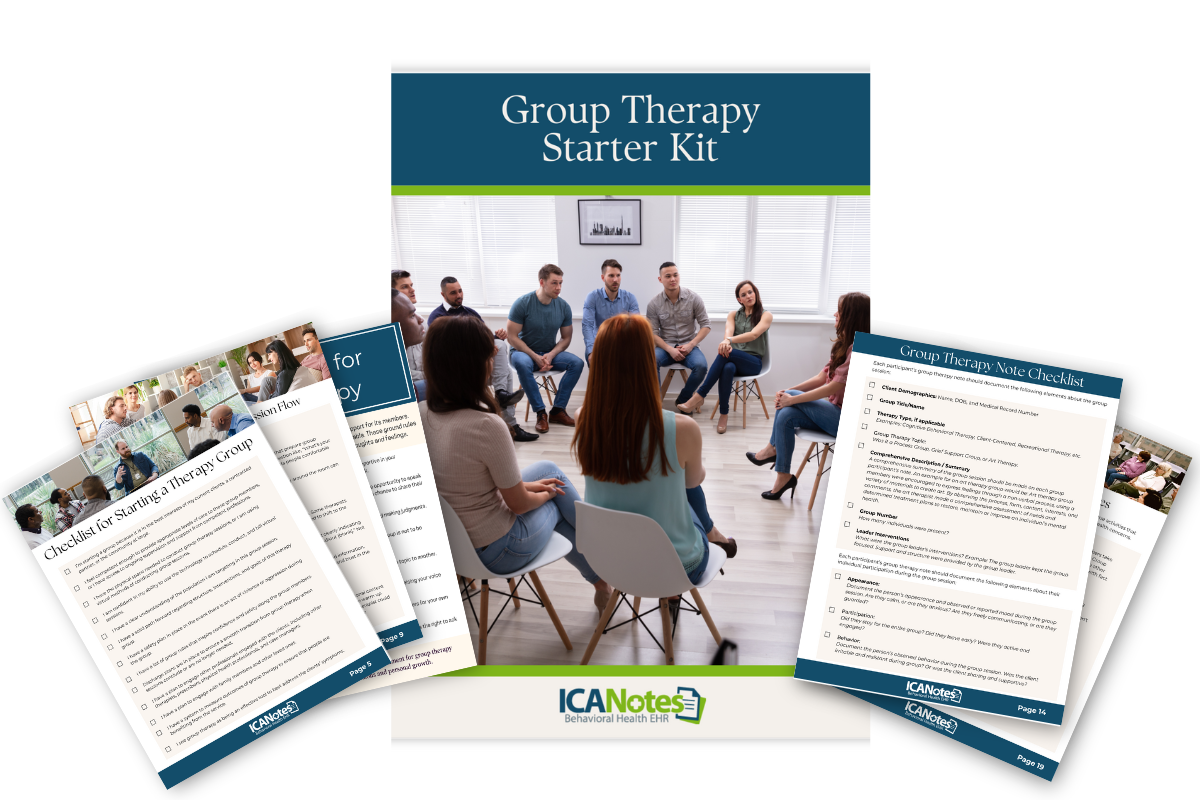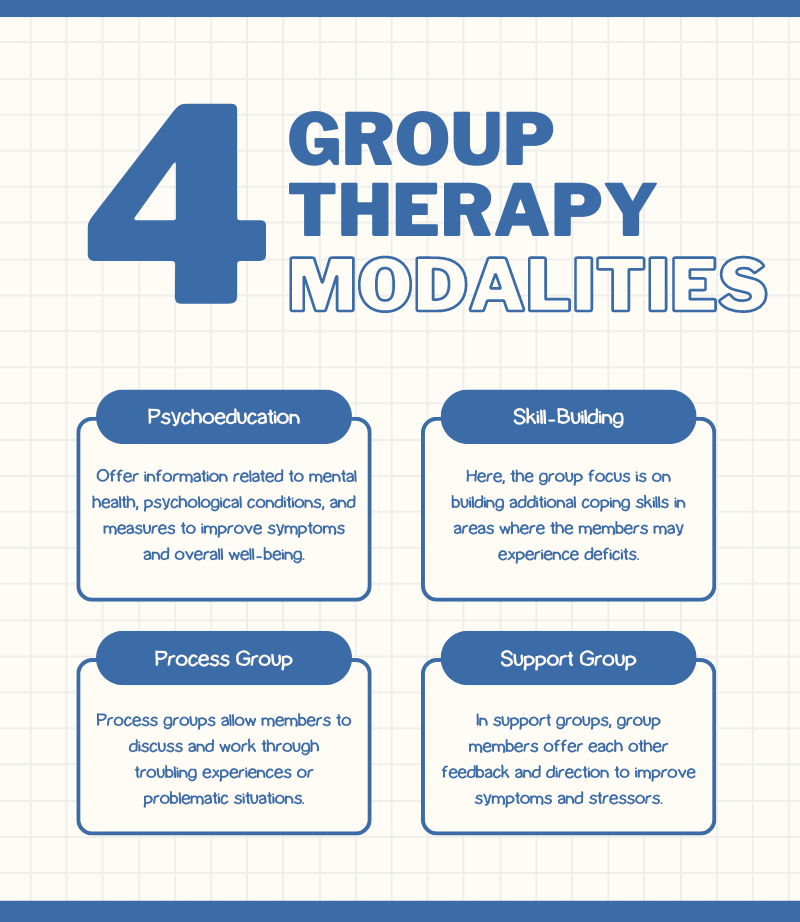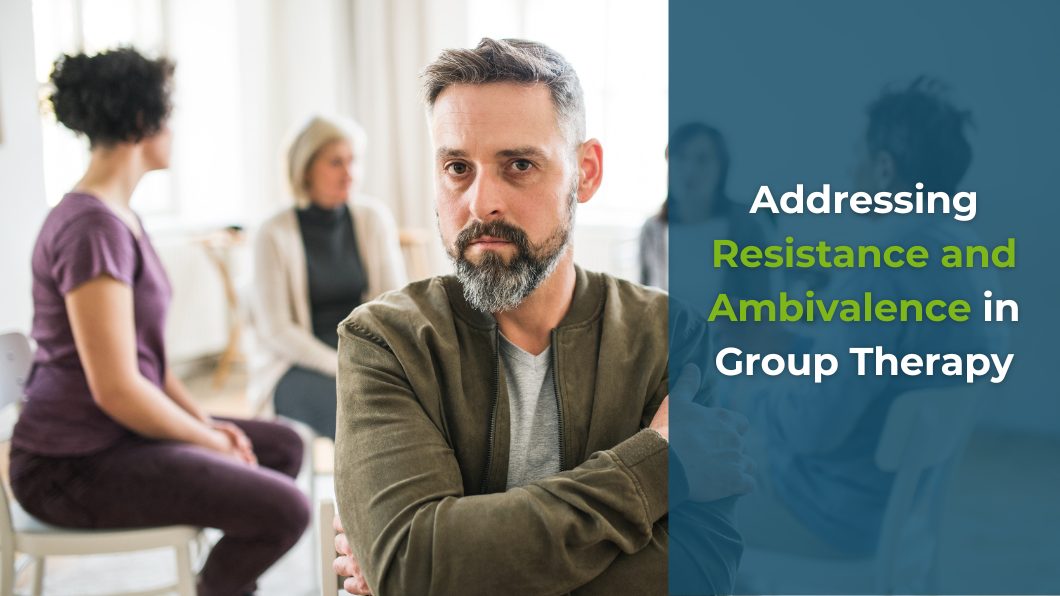
How to Start a Therapy Group: Picking Topics and Modalities
Now that you’ve decided to start a therapy group, the hard work really begins. You’ll need to plan and prepare for your group and consider each part of the process. With group therapy, adopting an “I’ll figure it out as I go” mentality will likely result in a group that lacks successful progress and consistent participation.
This article will walk you through the process of how to start a therapy group, so your experience as a group therapy facilitator is as comfortable and rewarding as possible.
Free Download: Group Therapy Starter Kit

Finding your Group Therapy Topics
For many, the hardest part of how to start a therapy group is deciding on the group therapy topics. Figuring out what you want to work on and how you are going to address the members’ symptoms might seem simple at first, but with a little consideration, you realize how complicated it actually is.
The group therapy focus can be an intimidating decision, because what you decide on will shape and influence every other part of the group. For example, if you want to start a group that addresses and resolves symptoms of depression, do you establish your group as a “Depression Group”? What about all the sources of depression and how differently it impacts people?
Instead, do you set up an “Improving Self-Esteem Group,” to address one of the biggest negatives of depression, or is this too narrow? Having a broad group may attract more potential clients, while a narrow group may exclude too many. Maybe a lot of people with depression don’t struggle with self-esteem issues.
When choosing your focus, you’ll need to balance overly broad with overly niche. You’ll want to seem inclusive of people to extend your appeal, while showing a speciality that shows your expertise.
Establishing Your Group Therapy Format
Once you have your group therapy topic, you’ll need to shift your attention to the practical aspects of your group. Where and when will it be, who can attend, how long will each group meeting be, and how long will it go on for? The answer to each question will heavily shape the look and feel of the group. Finding the best combination of answers may take some time, so it’s always helpful to approach your group therapy sessions with a sense of flexibility.(1)
Groups should be at least an hour long with some sessions being more effective when they are longer. Groups, especially at their outset, should be weekly, with some benefit from twice weekly sessions.
To better refine how to start a therapy group, you have to ask: Is the group:(2)
- Single or co-facilitated? Will you be running the group alone or in combination with another professional? If you are new to group therapy, having a co-facilitator should be a strong consideration. After some time, your experience and confidence will grow enough to go it alone if desired.
- In-person or virtual? Establishing your group therapy venue is essential, but you may not need to fret much about the options. Virtual group therapy sessions have been highly effective for a variety of issues, so not all groups must be in-person. Virtual sessions also require less physical space and less coordination. In-person group sessions do offer the therapist the ability to better assess and notice their clients’ responses as well as certain intangible benefits.
- Open or closed? Open groups allow people to come and go at any time. Closed groups only allow people to start the group at certain periods, if ever at all. Much of this depends on the projected content and flow of the sessions. Closed groups should begin with 8 to 10 clients, so there are enough members to maintain the sessions when some inevitably dropout.
- Time-limited or ongoing? Will you run this group for a total of 10 sessions, or do you see it going on indefinitely? New group therapists may appreciate the comfort of time-limited sessions over the uncertainty of ongoing sessions. Some therapists will transition a successful time-limited group to ongoing if the members are consistently benefiting from the meetings.
- Compatible with other treatments? Some group facilitators require their group members to attend individual sessions while participating in group. Some will require members to use medications as a complementary treatment, while others will prefer the opposite. In most cases, group therapy is a wonderful addition to other treatments and may not offer enough to replace all other forms of treatment.
- Theoretical or experiential? Do you see group members sitting and talking during their time in session, or are they moving, dancing, painting, and singing? All can be effective, but not all forms may appeal to all clients.
Evaluating Group Therapy Modalities
Having your format planned will drastically influence your group, but one last question stands before you: What is your group actually going to look like? Will you be standing by a white board and lecturing your clients about the ABC theory of personality as presented in the REBT style or will you sit back and say only a few words during a typical session? Will you lead the sessions or allow your members to manage the flow?
Even though these options sound very different, they can all be effective. There is no “right way” or “wrong way” to run a therapy group as long as you subscribe to a method and stick with it for a significant amount of time.
Some group therapy modalities include:(3)
- Psychoeducation. In these groups, the therapist primarily acts as a teacher. They offer information related to mental health, psychological conditions, and measures to improve symptoms and overall well-being.
- Skill-Building. Here, the group focus is on building additional coping skills in areas where the members may experience deficits. The therapist can offer assertive communication skills for people with poor relationships and relaxation skills for people with high stress.
- Process group. Process groups allow members to discuss and work through troubling experiences or problematic situations with a focus on their reactions and responses to the situation, rather than the actual details of the situation. By looking at the process over content, members can work to adjust their reactions to future situations.
- Support group. Support groups typically lack professional leaders, but this style of group may appeal to you. In support groups, group members offer each other feedback and direction to improve symptoms and stressors. The therapist takes a more passive role. If you choose a support group style, be sure you are active enough in the session to justify your billing to insurance companies.

Final Thoughts on How to Start a Therapy Group
Although it may seem like the questions associated with how to start a therapy group seem endless, each answer brings you closer to starting and running a successful and effective group. And the best part is that you can change and adjust the answers over time. Perhaps a group that started as a closed, time-limited, psychoeducation group transforms into an open, ongoing group that incorporates elements of all group therapy modalities. In group therapy, you are only limited by your creativity and flexibility.
ICANotes offers essential tools to document and track your sessions efficiently. By utilizing ICANotes, you can maintain comprehensive records, monitor group dynamics, and identify trends that inform your practice and streamlines the documentation process, freeing up more time for you to focus on facilitating a successful and impactful therapy group.
Book a demo and find out how to streamline your documentation process:
About the Author

Eric Patterson, MSCP, NCC, LPC
Eric Patterson, MSCP, NCC, LPC, is a professional counselor who has been working for over a decade to help children, adolescents, and adults in western Pennsylvania reach their goals and improve their well-being.
Along the way, Eric worked as a collaborating investigator for the field trials of the DSM-5 and completed an agreement to provide mental health treatment to underserved communities with the National Health Service Corp.
Sources
- Ezhumalai, S., et al. (2018). Group interventions. Indian Journal of Psychiatry.
- American Psychological Association. (2023). Group Therapist is as Effective as Individual Therapy, and More Efficient. Here’s How to Do It Successfully.
- Malhotra, A. and Baker, J. (2022). Group Therapy. StatPearls.








